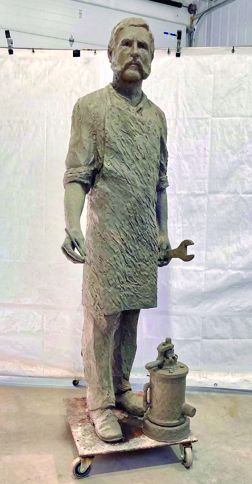Subscriptions
Menu
Advertisements
GW: statue to honor Central Bridge's most famous son
6/1/2023 |
By Rosemary Christoff Dolaan |

George Westinghouse, Old Central Bridge and Schenectady’s world-famous son, will be honored with the unveiling of a life-size bronze statue on Wednesday, June 14 at 5pm at South Ferry Street and Erie Boulevard, northwest corner, across from the Thomas Edison and Charles Steinmetz statues.
The ceremony will be followed by a reception at the First Reformed Church, 8 North Church Street, Covenant Hall, at 6:15pm.
The statue is the creation of sculptor Dexter Benedict and depicts George as a teenager working in his father’s shop.
Acclaimed in his time as the “greatest living engineer,” his pioneering work with railroads and electric power systems revolutionized these two industries.
Mr. Westinghouse was responsible for advancing the manufacture of power by devising a way to distribute electricity using alternating current.
George Westinghouse Jr. was born in Old Central Bridge on October 6, 1846.
George was the eighth of 10 children born to George Westinghouse Sr. and Emaline Vedder Westinghouse, both of whom came from generations of farmers and mechanics.
George’s father was a talented inventor in his own right, having built a wheat threshing machine that helped revolutionize American agriculture.
The threshing machine industry was the mainstay of Central Bridge during the last half of the nineteenth century.
By the age of seven, George Junior was already tinkering with making motors and machines.
When George was 10, his father moved the family to Schenectady where he established a farm implement manufacturing plant called G. Westinghouse & Co. It was located where the General Electric company would later be built.
Young George worked at his father’s shop in Schenectady starting at age 13, earning 50 cents a day.
By the age of 15, he invented the rotary steam engine for which he would receive his first patent four years later, in 1865.
In his work with railroads, he began to search for a way to stop trains reliably and quickly. Up until that time stopping a heavy train was hit and miss.
He was looking for a centralized system that could be operated by the engineer in the locomotive.
On April 13, 1869, while still a resident of Schenectady, Westinghouse received his patent for the air brake.
At age 22, he went on to form the Westinghouse Air Brake Company at Wilmerding, Pennsylvania, and later, the Westinghouse Electric Company at Pittsburgh.
Unlike Thomas Edison, Westinghouse was not a relentless self-promoter.
He was a humanitarian and visionary who fathomed that his inventions would benefit mankind.
He had a charismatic personality and affable disposition, but was no pushover. He stood his ground articulately in letters to the newspaper and in court against his detractors. There were many who tried to discredit him.
Foremost among those was Thomas Edison.
Mr. Edison, a longtime proponent of direct current (DC), and Mr. Westinghouse, who perfected the alternating current (AC) distribution of electricity, were bitter rivals in the “War of the Electric Currents.” Mr. Edison’s existing DC current motors were costly and complex, with low power output not capable of running electricity more than one-half mile. Mr. Edison and his cronies launched a vicious battle against the Westinghouse AC current and fought to have it outlawed.
Westinghouse purchased patents from inventor Nikola Tesla.
Like Mr. Westinghouse, Tesla was an idealist who understood that his groundbreaking induction motor and polyphase system would help make the world a better place.
Tesla sold the manufacturing rights to Mr. Westinghouse, and they worked to perfect a way to distribute electricity over long distances using AC current.
Alternating current proved to be an economical and practical delivery system across long distances.
Mr. Westinghouse won the War of the Currents and it is Westinghouse AC current that lights and powers our world today.









